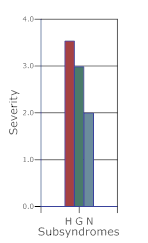Time Phases of Acute Radiation Syndrome (ARS) - Dose Range 6-8 Gy

|
Dose Range in gray (Gy) (What is gray?) Data adapted from: Diagnosis and Treatment of Radiation Injuries (PDF - 202 KB) (IAEA Safety Reports Series No. 2, Vienna 1998) |
 |
Timeline: 6-8 Gy  ARS time phases and approximate whole body dose from exposure: 6-8 Gy
|
||||||||||||||



